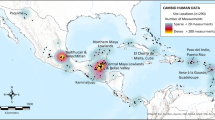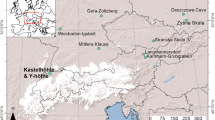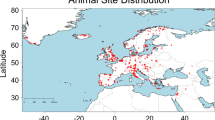Abstract
Island colonization and subsequent dwarfing of Pleistocene proboscideans is one of the more dramatic evolutionary and ecological occurrences1,2,3, especially in situations where island populations survived end-Pleistocene extinctions whereas those on the nearby mainland did not4. For example, Holocene mammoths have been dated from Wrangel Island in northern Russia4. In most of these cases, few details are available about the dynamics of how island colonization and extinction occurred. As part of a large radiocarbon dating project of Alaskan mammoth fossils, I addressed this question by including mammoth specimens from Bering Sea islands known to have formed during the end-Pleistocene sea transgression5. One date of 7,908 ± 100 yr bp (radiocarbon years before present) established the presence of Holocene mammoths on St Paul Island, a first Holocene island record for the Americas. Four lines of evidence—265 accelerator mass spectrometer (AMS) radiocarbon dates from Alaskan mainland mammoths6, 13 new dates from Alaskan island mammoths, recent reconstructions of bathymetric plots5 and sea transgression rates from the Bering Sea5—made it possible to reconstruct how mammoths became stranded in the Pribilofs and why this apparently did not happen on other Alaskan Bering Sea islands.
This is a preview of subscription content, access via your institution
Access options
Subscribe to this journal
Receive 51 print issues and online access
$199.00 per year
only $3.90 per issue
Buy this article
- Purchase on Springer Link
- Instant access to full article PDF
Prices may be subject to local taxes which are calculated during checkout


Similar content being viewed by others
References
Palombo, M. R. The World of Elephants. Proc. 1st Internatl. Cong. 486–491 (Comune Di Roma, Consiglio Nazionale della Ricerche, Rome, 2001)
Sondaar, P. Y. in Major Patterns of Vertebrate Evolution (eds Hecht, M. K., Goody, P. C. & Hecht, M. B.) 671–707 (Plenum, New York, 1977)
Agenbroad, L. D. Pygmy mammoths, Mammuthus exilis, from Channel Islands National Park, California (USA). Deinsea 9, 1–39 (2003)
Vartanyan, S. L., Garutt, V. E. & Sher, A. V. Holocene dwarf mammoths from Wrangel Island in the Siberian Arctic. Nature 362, 336–339 (1993)
Manley, W. F. Postglacial Flooding of the Bering Land Bridge: A Geospatial Animation v1. INSTAAR2002 〈http://instaar.colorado.edu/QGISL/bering_land_bridge〉
Guthrie, R. D. Rapid body size decline in Alaskan Pleistocene horses before extinction. Nature 426, 169–171 (2003)
Falconer, D. S. An Introduction to Quantitative Genetics (Longman, Harlow, 1989)
Frankham, R. Inbreeding and extinction: island populations. Conserv. Biol. 12, 665–675 (2000)
Hopkins, D. M. & Einarsson, T. Pleistocene glaciation on St. George Is. Pribilof Islands. Science 152, 343–345 (1966)
Sulerzhitsky, L. D. & Romanenko, F. A. The ‘twilight’ of the mammoth fauna in the Asiatic Arctic. Ambio 28, 251–255 (1999)
Crossen, K. J., Graham, R. W., Veltre, D. W. & Yesner, D. Abstr. Ann. Geol. Soc. Am. Conf. NW Div. 424 (Geol. Soc. Am., Seattle, Washington, 2003)
Scheffer, V. B. Rise and fall of a reindeer herd. Sci. Monthly 73, 356–362 (1951)
Colinvaux, P. A. Historical ecology in Beringia: the south land bridge coast at St. Paul Island. Quat. Res. 16, 18–36 (1981)
Guthrie, R. D. Frozen Fauna of the Mammoth Steppe (Univ. Chicago Press, Chicago, 1990)
Ager, T. A. Late Quaternary vegetation and climate history of the Bering Land Bridge from St. Michael Island western Alaska. Quat. Res. 60, 17–31 (2003)
Martin, P. S. in Quaternary Extinctions (eds Martin, P. S. & Klein, R. G.) 345–403 (Univ. Arizona Press, Tucson, 1984)
Guthrie, R. D. in Quaternary Extinctions (eds Martin, P. S. & Klein, R. G.) 259–298 (Univ. Arizona Press, Tucson, 1984)
Agenbroad, L. D., Johnson, J. & Morris, D. Abstr. Am. Quat. Assoc. 17th AMQUA Biennial Meeting (Am. Quat. Assoc., Univ. Alaska, Anchorage, 2002)
Fitzhugh, W. W. Global cultural change: new views of circumpolar lands and people. Anthro. News Natl Mus. Nat. Hist. 9, 1 (1997)
Gerasimov, D., Girya, E., Pitulko, V. & Tikhonov, A. New Materials for the Interpretation of the Site Chertov Ovrag on the Wrangel Island [in Russian] 379–383 (Mat. 2nd Dikov's conf., Magadan, SVKNII, 2002)
Fladmark, K. R. Routes: alternate migration corridors for early man in North America. Am. Antiq. 4, 55–69 (1977)
Laws, R. M., Parker, I. S. C. & Johnston, R. C. B. Elephants and their Habitats: the Ecology of Elephants in North Bunyoro, Uganda (Clarendon, Oxford, 1975)
Lister, A. M. Epiphyseal fusion and postcranial age determination in woolly mammoth. Ann. Nat. Hist. Mus. Rotterdam 6, 79–87 (1999)
Acknowledgements
I thank O. Geist and R. Carroll who collected these island fossils, and the curators of the UAM, USNM and ANMH. M. L. Guthrie edited the manuscript. A. Lister and A. J Stuart provided reviews, and they also corroborated the mammoth date using their NERC Grant. My dating projects have been funded by the NSF.
Author information
Authors and Affiliations
Corresponding author
Ethics declarations
Competing interests
The author declares that he has no competing financial interests.
Supplementary information
Supplementary Information
Specimen details and radiocarbon dates. (XLS 44 kb)
Rights and permissions
About this article
Cite this article
Dale Guthrie, R. Radiocarbon evidence of mid-Holocene mammoths stranded on an Alaskan Bering Sea island. Nature 429, 746–749 (2004). https://doi.org/10.1038/nature02612
Received:
Accepted:
Issue Date:
DOI: https://doi.org/10.1038/nature02612
This article is cited by
-
Origins and diversity of the Bering Sea Island fauna: shifting linkages across the northern continents
Biodiversity and Conservation (2021)
-
Pattern of extinction of the woolly mammoth in Beringia
Nature Communications (2012)
-
On strontium and barium anomalies in the sediments of Charkadio Cave (Tilos Island, Dodekanese, Greece)
Journal of Radioanalytical and Nuclear Chemistry (2008)
-
Late Quaternary loss of genetic diversity in muskox (Ovibos)
BMC Evolutionary Biology (2005)
Comments
By submitting a comment you agree to abide by our Terms and Community Guidelines. If you find something abusive or that does not comply with our terms or guidelines please flag it as inappropriate.



